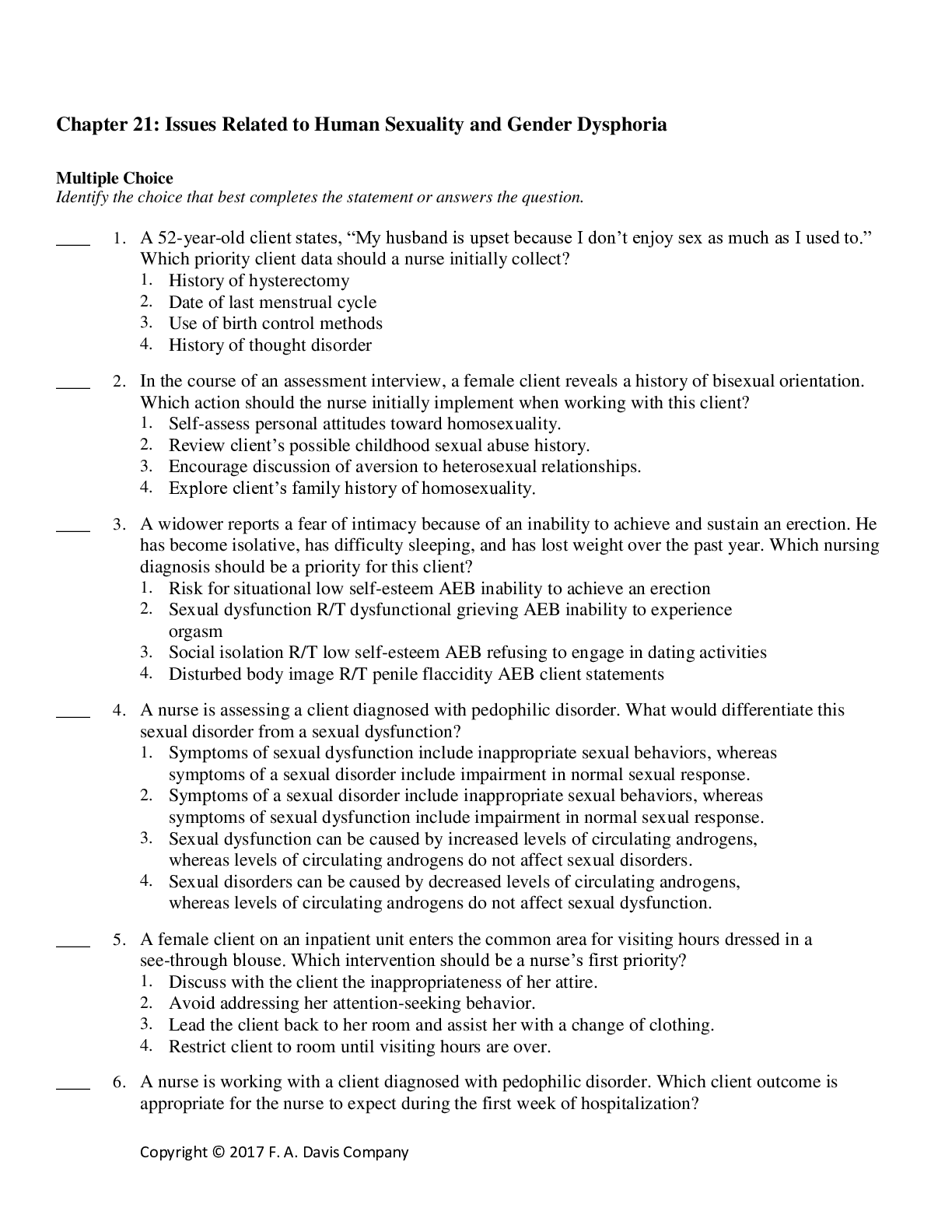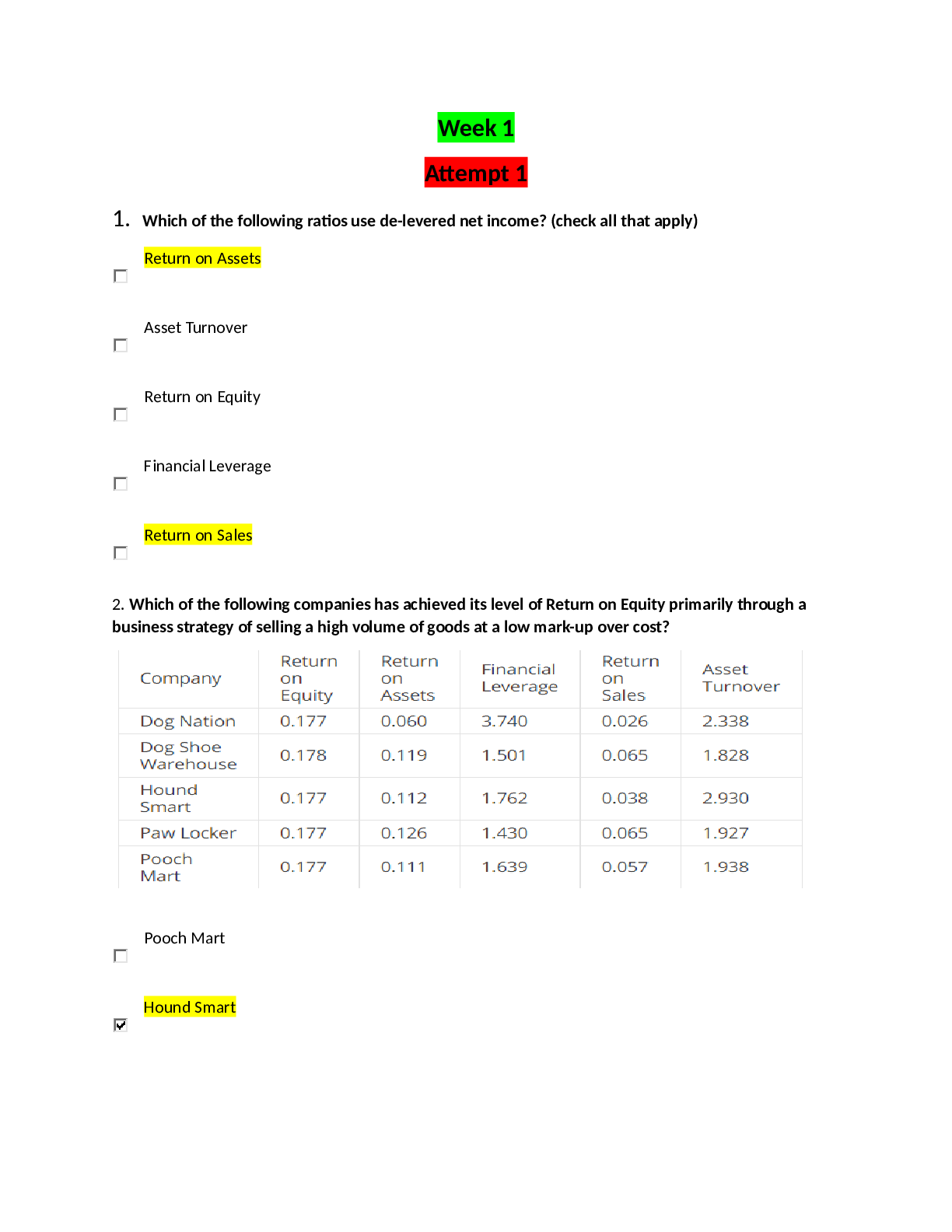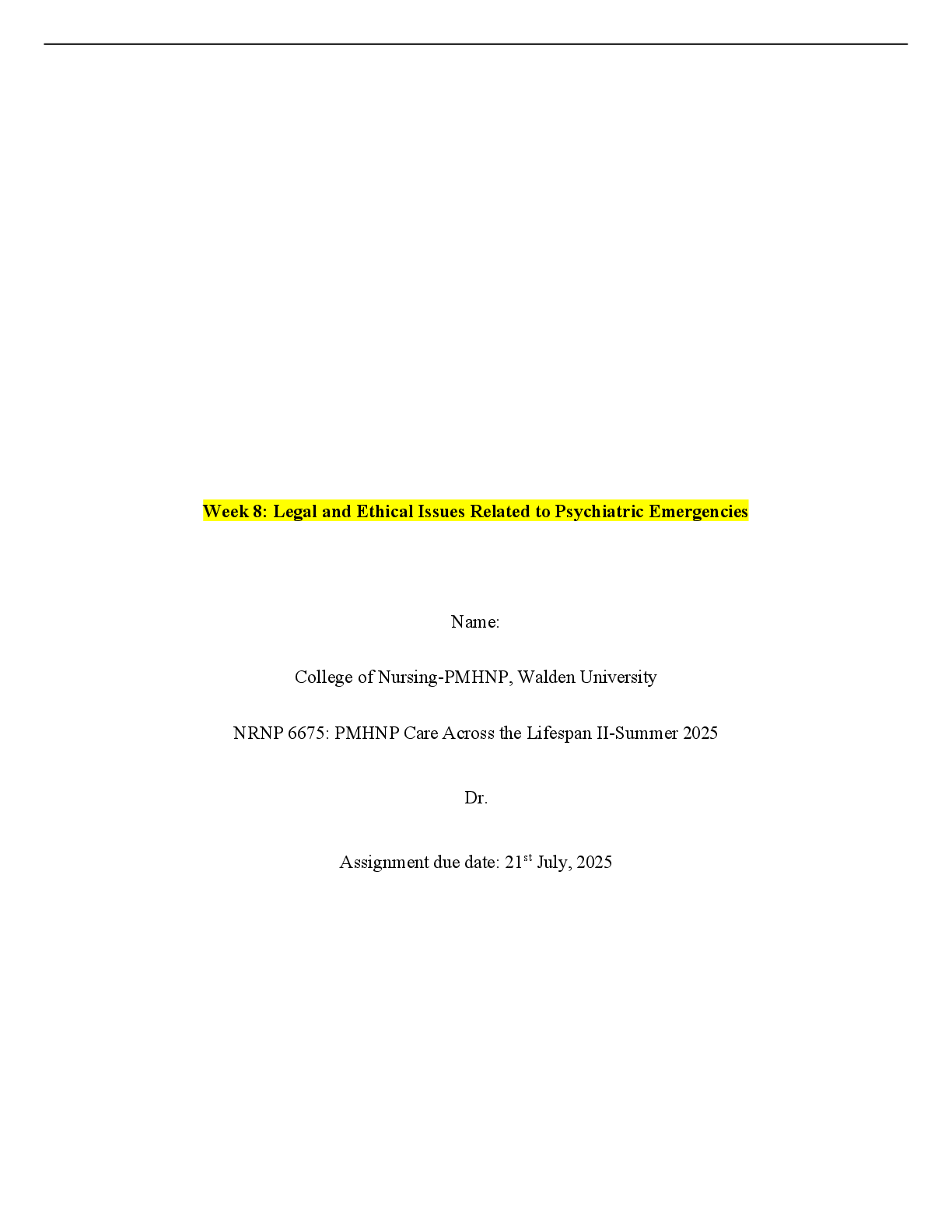*NURSING > QUESTIONS & ANSWERS > Chapter 21: Issues Related to Human Sexuality and Gender Dysphoria. With Answers Explained (All)
Chapter 21: Issues Related to Human Sexuality and Gender Dysphoria. With Answers Explained
Document Content and Description Below
Multiple Choice Identify the choice that best completes the statement or answers the question. ____ 1. A 52-year-old client states, “My husband is upset because I don’t enjoy sex as much as I ... used to.” Which priority client data should a nurse initially collect? 1. History of hysterectomy 2. Date of last menstrual cycle 3. Use of birth control methods 4. History of thought disorder ____ 2. In the course of an assessment interview, a female client reveals a history of bisexual orientation. Which action should the nurse initially implement when working with this client? 1. Self-assess personal attitudes toward homosexuality. 2. Review client’s possible childhood sexual abuse history. 3. Encourage discussion of aversion to heterosexual relationships. 4. Explore client’s family history of homosexuality. ____ 3. A widower reports a fear of intimacy because of an inability to achieve and sustain an erection. He has become isolative, has difficulty sleeping, and has lost weight over the past year. Which nursing diagnosis should be a priority for this client? 1. Risk for situational low self-esteem AEB inability to achieve an erection 2. Sexual dysfunction R/T dysfunctional grieving AEB inability to experience orgasm 3. Social isolation R/T low self-esteem AEB refusing to engage in dating activities 4. Disturbed body image R/T penile flaccidity AEB client statements ____ 4. A nurse is assessing a client diagnosed with pedophilic disorder. What would differentiate this sexual disorder from a sexual dysfunction? 1. Symptoms of sexual dysfunction include inappropriate sexual behaviors, whereas symptoms of a sexual disorder include impairment in normal sexual response. 2. Symptoms of a sexual disorder include inappropriate sexual behaviors, whereas symptoms of sexual dysfunction include impairment in normal sexual response. 3. Sexual dysfunction can be caused by increased levels of circulating androgens, whereas levels of circulating androgens do not affect sexual disorders. 4. Sexual disorders can be caused by decreased levels of circulating androgens, whereas levels of circulating androgens do not affect sexual dysfunction. ____ 5. A female client on an inpatient unit enters the common area for visiting hours dressed in a see-through blouse. Which intervention should be a nurse’s first priority? 1. Discuss with the client the inappropriateness of her attire. 2. Avoid addressing her attention-seeking behavior. 3. Lead the client back to her room and assist her with a change of clothing. 4. Restrict client to room until visiting hours are over. ____ 6. A nurse is working with a client diagnosed with pedophilic disorder. Which client outcome is appropriate for the nurse to expect during the first week of hospitalization? 1. The client will verbalize an understanding of the importance of follow-up care. 2. The client will implement several relapse-prevention strategies. 3. The client will identify triggers for inappropriate behaviors. 4. The client will attend aversion therapy groups. ____ 7. When planning care for a client diagnosed with female sexual interest/arousal disorder, what should the nurse document as an expected outcome of sensate focus exercises? 1. To initiate immediate orgasm 2. To reduce anxiety by eliminating physical touch 3. To focus on touching breasts and genitals 4. To reduce goal-oriented demands of intercourse ____ 8. A newly married woman comes to a gynecology clinic reporting anorexia, insomnia, and extreme pain during intercourse that has affected her intimate relationship. What initial intervention should the nurse expect a physician to implement? 1. A thorough physical, including gynecological examination 2. Referral to a sex therapist 3. Assessment of sexual history and previous satisfaction with sexual relationships 4. Referral to the recreational therapist for relaxation therapy ____ 9. A nurse is instructing a client diagnosed with female sexual interest/arousal disorder. Which symptom and treatment of this disorder should the nurse describe to the client? 1. Avoidance of all genital sexual contact treated by sensate focus exercises 2. Avoidance of all genital sexual contact treated by medicating with tadalafil (Cialis) 3. Anorgasmia treated by vardenafil (Levitra) 4. Anorgasmia treated by systematic desensitization ____ 10. A nurse is counseling a client diagnosed with gender dysphoria. What criteria would differentiate this disorder from a transvestic disorder? 1. Clients diagnosed with transvestic disorder are dissatisfied with their gender, whereas clients diagnosed with gender dysphoria are not. 2. Clients diagnosed with gender dysphoria are dissatisfied with their gender, whereas clients diagnosed with transvestic disorder are not. 3. Clients diagnosed with gender dysphoria avoid all forms of sexual intercourse, whereas clients diagnosed with transvestic disorder do not. 4. Clients diagnosed with transvestic disorder avoid all forms of sexual intercourse, whereas clients diagnosed with gender dysphoria do not. ____ 11. A nurse is assessing a client diagnosed with sexual masochistic disorder. What would differentiate this paraphilic disorder from sexual sadistic disorder? 1. Symptoms of sexual masochistic disorder are chronic acts of humiliation, whereas symptoms of sexual sadistic disorder are acute. 2. Symptoms of sexual sadistic disorder are chronic acts of humiliation, whereas symptoms of sexual masochistic disorder are acute. 3. Masochistic acts can be performed alone, whereas sadistic acts must have a consenting or non-consenting partner. 4. Sadistic acts can be performed alone, whereas masochistic acts must have a consenting or nonconsenting partner. ____ 12. A nurse is assessing a client diagnosed with fetishistic disorder. What would differentiate this paraphilic disorder from frotteuristic disorder? 1. To derive sexual excitement, fetishistic disorder involves the use of nonliving objects, whereas frotteuristic disorder involves touching and rubbing against nonconsenting people. 2. To derive sexual excitement, frotteuristic disorder involves the use of nonliving objects, whereas fetishistic disorder involves touching and rubbing against nonconsenting people. 3. Clients diagnosed with frotteuristic disorder are heterosexual cross-dressing males, whereas clients diagnosed with fetishistic disorder are homosexual cross-dressing males. 4. Clients diagnosed with fetishistic disorder are heterosexual cross-dressing males, whereas clients diagnosed with frotteuristic disorder are homosexual cross-dressing males. Multiple Response Identify one or more choices that best complete the statement or answer the question. ____ 13. Which of the following characteristics should a nurse identify as “normal” in the development of human sexuality for an 11-year-old child? (Select all that apply.) 1. The child experiments with masturbation. 2. The child may experience homosexual play. 3. The child shows little interest in the opposite sex. 4. The child shows little concern about physical attractiveness. 5. The child is unlikely to want to undress in front of others. ____ 14. A nursing instructor is teaching about the various categories of paraphilic disorders. Which categories are correctly matched with expected behaviors? (Select all that apply.) 1. Exhibitionistic disorder: Mary models lingerie for a company that specializes in home parties. 2. Voyeuristic disorder: John is arrested for peering in a neighbor’s bathroom window. 3. Frotteuristic disorder: Peter enjoys subway rush-hour female contact that results in arousal. 4. Pedophilic disorder: George can experience an orgasm by holding and feeling shoes. 5. Fetishistic disorder: Henry masturbates into his wife’s silk panties. ____ 15. A client is diagnosed with erectile disorder. Which of the following medications would address this condition, and what is the therapeutic action of the drug? (Select all that apply.) 1. Phentolamine (Oraverse); increases blood flow to the penis 2. Apomorphine (Apokyn); acts directly on the dopamine receptors in the brain 3. Vardenafil (Levitra); blocks the action of phosphodiesterase-5 (PDE5) 4. Goserelin (Zoladex); inhibits the production of gonadotropins 5. Sildenafil (Viagra); blocks the action of phosphodiesterase-5 (PDE5) ____ 16. A nurse is planning care for a child diagnosed with gender dysphoria. Which of the following nursing diagnoses could potentially document this client’s problems? (Select all that apply.) 1. Low self-esteem R/T rejection by peers 2. Self-care deficit R/T isolative behaviors 3. Disturbed personal identity R/T parenting patterns 4. Impaired social interactions R/T socially unacceptable behaviors 5. Activity intolerance R/T fatigue Completion Complete each statement. 17. ___________________________ is the constitution and life of an individual relative to characteristics regarding intimacy. [Show More]
Last updated: 2 years ago
Preview 1 out of 14 pages

Buy this document to get the full access instantly
Instant Download Access after purchase
Buy NowInstant download
We Accept:

Reviews( 0 )
$6.00
Can't find what you want? Try our AI powered Search
Document information
Connected school, study & course
About the document
Uploaded On
Jan 28, 2020
Number of pages
14
Written in
Additional information
This document has been written for:
Uploaded
Jan 28, 2020
Downloads
0
Views
144






.png)
.png)
.png)
.png)
.png)
.png)
.png)


.png)
.png)


